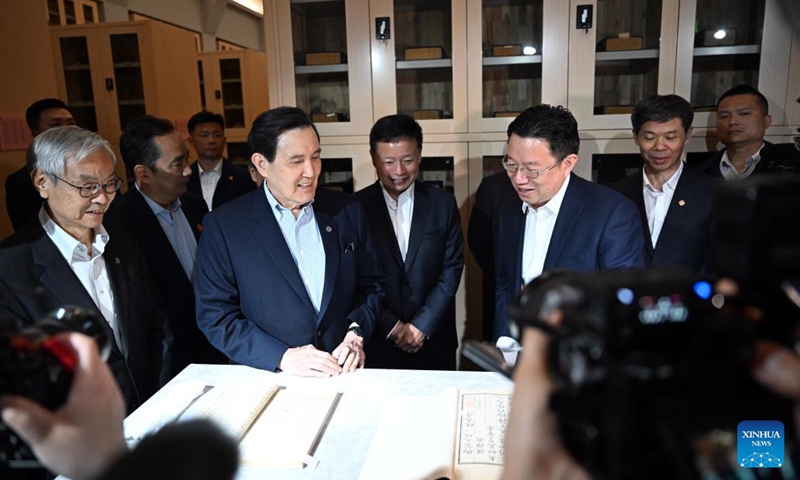
Ma Ying-jeou, former chairman of the Chinese Kuomintang party, looks through collections of the archives at the Xi'an branch of the China National Archives of Publications and Culture in Xi'an, northwest China's Shaanxi Province, April 6, 2024. Ma and a Taiwan youth delegation visited the Xi'an branch of the China National Archives of Publications and Culture on Saturday. Photo: Xinhua
During a trip in the Chinese mainland, the former chairperson of the Kuomintang (KMT) party Ma Ying-jeou recommended ancient texts as "must read" when visiting a branch of China National Archives of Publications and Culture in Xi'an, Northwest China's Shaanxi Province as the ancient texts prove that the Diaoyu Islands do not belong to Ryukyu.
Xinhua reported that Ma led a group of Taiwan young people to visit the Xi'an branch of the China National Archives of Publications and Culture (CNAPC) located at the foot of the Guifeng Mountain in the northern foothills of the Qinling Mountains on Saturday. The CNAPC has its headquarters in Beijing, with three branches located in Xi'an, Hangzhou, and Guangzhou. They each have their own unique characteristics while complementing each other, jointly undertaking the important task of permanently and safely preserving outstanding Chinese editions and continuing the historical context.
During the visit, Director of the CNAPC Liu Chengyong, explained the selected collections of the main and branch museums to Ma. This included the Song Dynasty's rubbings of Xi Lou Su Tie, the Ming Dynasty's manuscript of the Yongle Encyclopedia, the Ming Dynasty's manuscript of Records of Envoys to Ryukyu.
While visiting the manuscript of Records of Envoys to Ryukyu, Liu explained that the book was written by Chen Kan in the 13th year of Jiajing (1534 AD) after serving as an envoy to the Ryukyu Kingdom to confer the king and returning to East China's Fujian Province. The book stated, "On the tenth day, the south wind was very fast, the boat moved like it was being carried by the wind, but it was not very turbulent even when going downstream. Passing by Pingjia Mountain, passing by the Diaoyu Islet... On the evening of the eleventh day, seeing the Kume Mountain, which belongs to Ryukyu."
Liu noted that the Diaoyu Islet is now known as the Diaoyu Islands, and the ancient texts clearly record the situation of the Diaoyu Islands outside of Ryukyu. This is an early version of the writing that proves that the Diaoyu Islands and its affiliated islands belong to China's territory.
After hearing this, Ma said, "This is something that researchers studying the Diaoyu Islands must read. It proves from ancient texts that the Diaoyu Islands do not belong to Ryukyu." He mentioned that he had seen related materials at Oxford University but not in full, and there should be more publicity about relevant historical materials.
The young people who were part of delegation were amazed by the rich and precious Chinese excellent classical editions preserved in the museum, calling it "very spectacular."
"The museum has preserved so many ancient texts intact, making an indelible contribution to the dissemination of Chinese civilization," Ma said after the visit. "I look forward to the wisdom of Chinese civilization's ancient texts, like a bright light in the river of history, continuing to illuminate the future of the Chinese nation."
Ma is leading a group of Taiwan youth to the Chinese mainland on an 11-day trip from April 1 with their first stop in South China's Guangdong Province and later arriving in Shaanxi on April 3. Upon China's Tomb-Sweeping Day, or Qingming Festival on April 4, the former KMT leader participated in a public worship ceremony of China's legendary ancestor Huangdi, or the Yellow Emperor, followed by visits to the Ma Yuan Temple, Ma Yuan's Tomb, Famen Temple, Xi'an City Wall, the Museum of the First Emperor of Qin, and the Xi'an branch of the CNAPC.
Global Times




